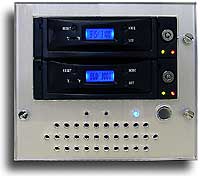Find more about USB cables Access USB devices remotely
The ezRAID is a hardware-based RAID solution that can accommodate two SATA hard drives and set up a one- or two drive RAID. It offers RAID 0, RAID 1, SPANNING and JBOD levels. The way the enclosure works is really simple – insert drives into the trays, set the RAID type with the configuration switch and connect it into a Firewire (FireWire RAID) or USB (USB RAID) port. No software application is required for the hardware to talk to your system

Built-in SATA to FireWire 800/ USB 2.0 controller that uses a 32bit RISC processor, an ORB (Operational Request Block) hardware coprocessor and a high performance buffer manager allow for managing RAID functionality in an efficient and easy way.
As you might know RAIDS can use a mix of striping, i.e. storing data across multiple disks, mirroring, i.e. duplicating one disk to another, and parity, i.e. enabling drive rebuilding via redundancy. Striped disks are really fast, mirrored disks are redundant, and parity is required for recovering the lost contents of either striped or mirrored drives. All of these configurations mix together in standard RAID levels – RAID 0 stripes data across disks for speed without any redundancy, and RAID 1 mirrors data across disks for redundancy.
Set to RAID 0, the ezRAID combines two disks into one. The data is split and written to both SATA hard drives at the same time, it means your data moves at a speed twice higher than it would have, had it been a single drive. The speed of sustained data transfer can reach 80 Mb/sec if the enclosure is connected to a FireWire 800.
ezRAID set at RAID 1 means that data writing is done for both SATA drives at the same time, the data of drive 1 is mirrored (backed up) on drive 2. Failure of one of the drives does not stop ezRAID from functioning – the other drive can be used for reading and writing. Once the corrupted drive is replaced, the data is automatically rebuilt in the background on a new drive.
SPANNING makes two disks appear as one volume, just like RAID 0 does. However unlike RAID 0, SPANNING writes data to one disk till it gets full and then starts writing on the other disk. This is handy when your drives are of different size and you need to use them as one volume.
Setting to JBOD (Just a Bunch of Drives) means that your system sees your drives as individual, i.e. separate, drives. This configuration is used if you want to have your drives separate, but connect to the system via a single port, be it FireWire or USB.
Share USB Hard Drive over LAN
It is possible to access a USB drive over network remotely, if you have a compact app called USB via Ethernet.
It allows you to connect to USB devices attached to other computers over LAN/ WAN/ Internet and use their functionality and contents as if they were inserted locally. This is how:
1. First, download and install the application on both computers – the one to which ezRAID is connected and the one that needs to access it.
2. Launch USB Network Gate on the former, locate USB hard drive in the list of available devices and click ‘Share’ next to it.
3. Now open the application on the other computer. The shared device should be displayed there, click ‘Connect’ to start using it - that’s it.